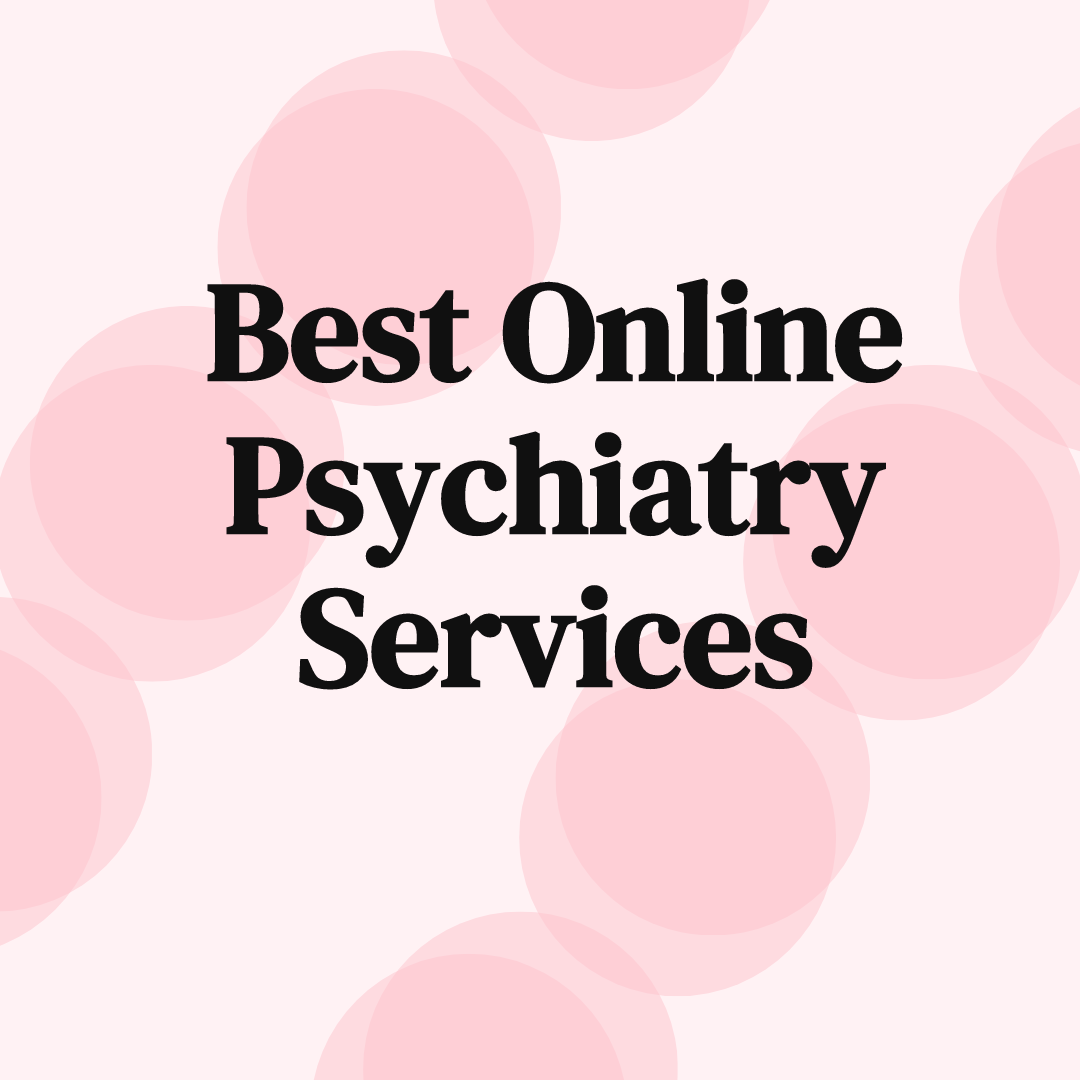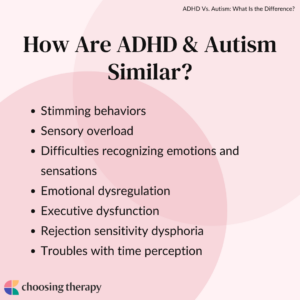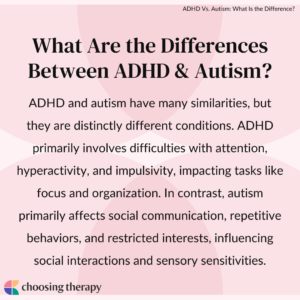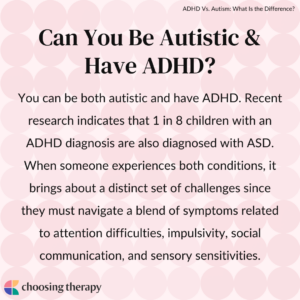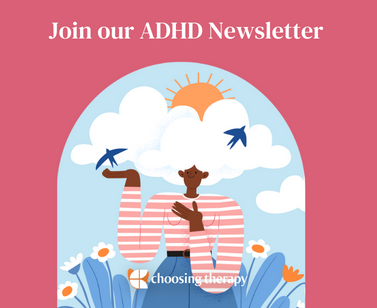ADHD and autism are neurodevelopmental conditions that share some overlapping symptoms, such as difficulties with focus, sensory sensitivities, and emotion regulation. ADHD primarily involves problems with attention, impulsivity, and hyperactivity, while challenges in social communication, repetitive behaviors, and restricted interests are more characteristic of autism.
Online Psychiatry For ADHD Covered By Insurance Talkiatry can match you with a real psychiatrist who takes your insurance and is seeing new patients. They’re in-network with major insurers and offer medication management. Get started with a short online assessment
What Is ADHD?
Attention-deficit/hyperactivity disorder (ADHD) is a neurodevelopmental condition that affects a person’s ability to focus, control impulses, and manage their energy levels. It often starts in childhood and can continue into adulthood. Symptoms like inattention, hyperactivity, and impulsivity characterize ADHD. Statistics show that ADHD is more often diagnosed in boys than girls, with a ratio of approximately 4:1.1
Risk factors for developing ADHD include genetic predisposition, family history of the disorder, exposure to environmental toxins during pregnancy, premature birth, and low birth weight.2 However, it’s important to note that while ADHD has these risk factors, it is a complex condition, and its exact causes are not fully understood.
The three subtypes of ADHD are:3
- Hyperactive-impulsive ADHD: Hyperactive-impulsive ADHD is characterized by prominent symptoms of hyperactivity and impulsivity. Individuals with this subtype often struggle with restlessness, fidgeting, difficulty staying seated, interrupting others, and acting without thinking.
- Inattentive ADHD: Inattentive ADHD is characterized by significant difficulties with sustained attention, organization, and following through on tasks. People with this subtype often struggle with forgetfulness, being easily distracted, and having trouble completing assignments or chores.
- Combined ADHD: Combined ADHD involves a combination of inattention, hyperactivity, and impulsivity symptoms. Individuals with combined ADHD experience challenges in focusing, controlling impulses, and managing excessive energy levels, which can impact various aspects of their daily lives.
What Is Autism?
Autism is a complex condition that affects a person’s social interaction, communication, and behavior. Individuals with autism often display a wide range of symptoms and experiences, making it a “spectrum” disorder. Common symptoms of autism include difficulty understanding and responding to social cues, difficulty with verbal and nonverbal communication, repetitive behaviors, and intense interest in specific topics.
Sensory sensitivities, such as being hypersensitive or hyposensitive to sensory stimuli like lights, sounds, or textures, are also frequently observed in individuals with autism. Some individuals with autism may also engage in sensory-seeking behaviors. These behaviors include actively seeking sensory stimulation to regulate, which may consist of repetitive activities like spinning objects or tactile stimulation through touch or pressure. According to one study, 32% of participants diagnosed with autism had symptoms of sensory sensitivities.4
How Are ADHD & Autism Similar?
ADHD and autism share some similarities, including difficulties with attention and concentration, leading to distractibility and task-related struggles. Additionally, individuals with both ADHD and autism might experience social difficulties, although the nature of these challenges can differ.
Similarities between ADHD and autism include:
Stimming Behaviors
Short for self-stimulatory behaviors, stimming is a repetitive and often rhythmic action or movements individuals engage in to self-soothe, regulate sensory input, or express themselves. Stimming for individuals with ADHD may include fidgeting their feet or tapping their fingers. Stimming for individuals with autism can include hand-flapping, rocking, or tapping, serving various sensory and emotional purposes.
Sensory Overload
Challenges in processing and responding to sensory information from the environment. Individuals with sensory problems may be hypersensitive (overly reactive) or hyposensitive (under-reactive). Individuals with autism and ADHD may experience sensitivity to sensory stimuli like sounds, lights, textures, or smells. This can lead to autistic and ADHD overstimulation or sensory-seeking behaviors.
Difficulties Recognizing Emotions & Sensations
Individuals with ADHD and autism can have difficulty understanding their internal physical and emotional sensations. They may find it hard to recognize and accurately label their feelings, bodily sensations, or needs, impacting their self-awareness and emotional regulation.
Emotional Dysregulation
Emotional dysregulation is the inability to manage or control one’s emotions effectively. Individuals with ADHD often struggle with emotional dysregulation and may experience ADHD-induced mood swings. Similarly, people with autism may have unpredictable emotional responses, making maintaining emotional stability in various situations challenging.
Executive Dysfunction
Executive dysfunction is cognitive difficulty that affects a person’s ability to plan, organize, initiate tasks, switch between activities, and regulate their behavior effectively. Executive dysfunction is a common feature of ADHD and autism.
Rejection Sensitivity Dysphoria
Rejection sensitivity dysphoria (RSD) is a term used to describe an intense emotional reaction to perceived or actual rejection or criticism. Individuals with autism and ADHD can experience RSD and may experience overwhelming feelings of sadness, hurt, or anger in response to situations where they perceive they’ve been rejected, which can significantly impact their self-esteem and relationships.
Troubles With Time Perception
Individuals with ADHD and autism often have difficulty in accurately perceiving and estimating the passage of time. ADHD time blindness can make it difficult to gauge how long activities or tasks may take, leading to punctuality and time management issues. Similarly, people with autism often have difficulty determining the passage of time and struggle with time management.
Get Help For ADHD Talkiatry can match you with a real psychiatrist who takes your insurance and is seeing new patients. They’re in-network with major insurers and offer medication management. Get started with a short online assessment Inflow App – Inflow is the #1 science-based app to help you manage your ADHD. Their support system helps you understand your neurodiverse brain, and build lifelong skills. Free Trial
What Are the Differences Between ADHD & Autism?
ADHD and autism have many similarities, but they are distinctly different conditions. ADHD primarily involves difficulties with attention, hyperactivity, and impulsivity, impacting tasks like focus and organization. In contrast, autism primarily affects social communication, repetitive behaviors, and restricted interests, influencing social interactions and sensory sensitivities.
Here are five key differences between ADHD and autism:
1. Attention Difficulties
Attention difficulties show up differently in individuals with autism and ADHD. In ADHD, attention issues often involve problems with sustained focus, impulsivity, and distractibility. Children with ADHD may struggle to stay seated in class, complete tasks, or follow instructions. In adulthood, these difficulties can lead to challenges in staying organized and meeting deadlines.
In contrast, autistic individuals may have attention differences in social communication and sensory sensitivities. Autistic children may focus intensely on specific interests but find engaging in reciprocal social interactions challenging. For autistic adults, attention difficulties in autism may manifest as difficulty understanding social cues and managing sensory overload.
2. Communication
Communication differences exist between autistic individuals and those with ADHD. While both groups may face communication issues, they stem from distinct cognitive processes, with autistic individuals typically struggling with broader social communication difficulties, including nonverbal aspects, compared to those with ADHD.
Autistic individuals often struggle with both verbal and nonverbal communication, finding it challenging to interpret social cues, make eye contact, or engage in reciprocal conversations. They may have difficulty understanding emotions and may prefer more straightforward or literal communication.
On the other hand, individuals with ADHD may exhibit impulsive communication patterns, interrupting or talking continuously in conversations due to their impulsivity and difficulty with self-regulation. However, this is not necessarily an indicator of social communication challenges like those seen in autism.
3. Need for Routines
Both individuals with ADHD and autistic individuals often benefit from routines. Still, ADHD individuals may experience disruptions as a result of impulsivity and inattention, whereas folks with autism rely on routine to avoid sensory overload.
Autistic individuals tend to rely on routines for predictability and sensory regulation, and disruptions can lead to heightened anxiety and meltdowns due to the abrupt sensory and environmental changes they experience. While both groups may find routine disruptions challenging, autistic individuals typically react more intensely due to sensory sensitivities and reliance on a routine for emotional regulation.
In contrast, individuals with ADHD may benefit from routines that can provide structure and support for their attention difficulties, and ADHD impulsivity can be a significant barrier. They may struggle with following routines consistently, and impulsivity can lead to hasty behaviors or poorly thought-out decisions.
4. Special Interests
Special interests are a common feature in autism and ADHD but appear differently in each disorder. Many autistic individuals have intense, focused interests in specific topics or activities they pursue enthusiastically. These interests can be a source of comfort, expertise, and even joy for them, providing a sense of predictability and control.
While individuals with ADHD can also have intense interests or hobbies, these tend to be more sporadic and driven by impulsivity and hyperactivity. ADHD hyperfixations may come and go rapidly, whereas autistic special interests are often over more extended periods and are a significant part of the individual’s identity and daily life. While both involve intense focus, the nature and intensity of these interests differ between the two conditions.
4. Sensory Sensitivities
Autism and ADHD show similarities in sensory sensitivities, although the reason and impact of these sensitivities can vary between individuals. In Autism, sensory sensitivities typically result in difficulty regulating emotions because they are either overstimulated or understimulated. In ADHD, sensory overload can also occur, although they are often related to difficulties in regulating attention and focus. Individuals with ADHD may become easily distracted by sensory stimuli, such as background noises, making it challenging to concentrate on tasks.
Diagnosing ADHD Vs. Autism
Doctors, such as pediatricians, psychologists, and psychiatrists, diagnose ADHD and autism following a specific process and criteria. ADHD is generally diagnosed in childhood, with symptoms having appeared before the age of 12. This diagnosis includes an evaluation of behavior observations, parent and teacher reports, and rating scales to assess inattention, hyperactivity, and impulsivity symptoms.
Autism is typically diagnosed in early childhood, often by age 2 or 3, but similar to ADHD, it can also be diagnosed later in life. An autism diagnosis involves an assessment, observation, developmental history, and parent/caregiver interviews. Unlike ADHD, which focuses on observable behaviors, Autism diagnosis also considers developmental milestones and social communication challenges.
Online Psychiatry For ADHD Covered By Insurance Talkiatry can match you with a real psychiatrist who takes your insurance and is seeing new patients. They’re in-network with major insurers and offer medication management. Get started with a short online assessment
Can ADHD Be Misdiagnosed as Autism?
Misdiagnosing ADHD as autism, and vice versa, can occur because these conditions share some similar symptoms and challenges. Both ADHD and autism can involve difficulties with attention, impulsivity, and social interactions, which can make it tricky to tell them apart solely by observing how someone behaves. Additionally, some people have both ADHD and autism at the same time, which adds an extra layer of complexity to the diagnosis process.
When someone has both conditions, it can be even more challenging to pinpoint which symptoms are related to ADHD and which ones are linked to autism. This highlights the importance of a careful and thorough assessment by healthcare professionals specifically trained to assess both disorders.
Can You Be Autistic & Have ADHD?
You can be both autistic and have ADHD. Recent research indicates that 1 in 8 children with an ADHD diagnosis are also diagnosed with ASD.5 When someone experiences both conditions, it brings about a distinct set of challenges since they must navigate a blend of symptoms related to attention difficulties, impulsivity, social communication, and sensory sensitivities.
Management for ADHD Vs. Autism
To effectively manage ADHD and autism, it’s important to start early with intervention and support. The earlier you begin managing your symptoms, the better your chance to improve your daily functioning. Treatment approaches include behavioral therapies, educational adjustments, and, in the case of ADHD, medications, all tailored to meet your specific needs and challenges.
Management options for ADHD include:
- Cognitive behavioral therapy (CBT): CBT for ADHD teaches coping skills for ADHD, including enhancing executive functions, recognizing and disputing negative thoughts and self-criticism, self-tracking and setting objectives for better attention and concentration, managing emotions like frustration, anxiety, and impulsivity, and involving family for support and skill acquisition.
- Medications: Medications for ADHD include stimulants (e.g., methylphenidate, amphetamine) and non-stimulants (e.g., atomoxetine, guanfacine) are often prescribed to help improve attention, impulse control, and hyperactivity.
- Educational accommodations: ADHD can be considered a learning disability, and schools are required to provide accommodations such as Individualized Education Plans (IEPs) or 504 Plans to address academic challenges and create a supportive learning environment.
- Lifestyle modifications: Developing healthy routines, time management skills, and organizational strategies can help individuals with ADHD better manage daily tasks.
- Support Groups: Support groups can provide individuals and their families with valuable information, resources, and emotional support.
- Parent and family education: Educating parents and family members about ADHD can help them effectively understand and support the individual.
- Alternative Therapies: Some individuals explore complementary and alternative therapies like following an ADHD diet, practicing meditation for ADHD, or trying neurofeedback.
Management options for autism include:
- Physical therapy: Physical therapy primarily focuses on addressing physical impairments and promoting motor skills development
- Occupational therapy: Occupational therapists work on improving fine and large motor skills, sensory processing, and activities of daily living to enhance an individual’s independence and functioning.
- Parent training: Parents and caregivers can engage in training to learn strategies for managing challenging behaviors and supporting their child’s development.
- Sensory integration therapy: Sensory integration therapy addresses sensory sensitivities and helps individuals regulate their responses to sensory stimuli.
- Assistive technology: Communication devices and assistive technology tools can help nonverbal individuals express themselves and participate in activities.
- Alternative and complementary therapies: Some families explore alternative therapies like dietary modifications, music therapy for autism, or equine therapy.
- Social skills training: Social skills training helps individuals with autism develop and practice appropriate social interactions, understand nonverbal cues, and build friendships.
- Behavioral Interventions: Applied Behavior Analysis (ABA) is a widely used behavioral therapy focusing on improving communication, social skills, and behavior management.
- Speech and language therapy: Speech therapy can help individuals with autism improve communication skills, including language development, articulation, and pragmatic language (social communication).
- Educational support: People with autism can apply for individualized education plans (IEPs) or other educational accommodations, which can provide tailored support in school settings.
How to Cope With Co-occurring ADHD & Autism
Coping with co-occurring ADHD and autism involves several steps. Firstly, seek an evaluation from specialists in neurodevelopmental conditions to understand the specific challenges. Collaborate with a team to create a personalized treatment plan, including therapies, educational adjustments, and medication as needed. Secondly, educate yourself and those around you about ADHD and autism to enhance your understanding of how they present together.
Communication with family and healthcare providers is important for sharing experiences and addressing challenges. Implement tailored behavioral strategies to manage attention, social skills, and sensory sensitivities. Engage with support groups for guidance and find stress-management techniques. Advocate for your rights in educational and workplace settings, celebrate small victories, and maintain an ongoing relationship with healthcare professionals for plan adjustments.
In My Experience
To help our readers take the next step in their mental health journey, Choosing Therapy has partnered with leaders in mental health and wellness. Choosing Therapy is compensated for marketing by the companies included below. ADHD Management Tools Inflow App Inflow is the #1 science-based app to help you manage your ADHD. Their support system helps you understand your neurodiverse brain, and build lifelong skills. Free Trial Online Psychiatry Circle Medical – ADHD Diagnosis and Treatment. Affordable and accessible ADHD evaluations and treatment, including possible controlled substances medication if clinically appropriate. Diagnosis and prescription over video. Insurance accepted. Same & next day appointments available. Visit Circle Medical Online Therapy BetterHelp Get support and guidance from a licensed therapist. BetterHelp has over 20,000 therapists who provide convenient and affordable online therapy. Take A Free Online Assessment and get matched with the right therapist for you. Free Assessment Free ADHD Newsletter A free newsletter from Choosing Therapy for those impacted by ADHD. Get helpful tips and the latest information. Sign Up Choosing Therapy Directory You can search for therapists by specialty, experience, insurance, or price, and location. Find a therapist todayAdditional Resources
Do you think you have ADHD? Answer an evidence-based questionnaire for Circles Medical to learn more. Takes 45 seconds.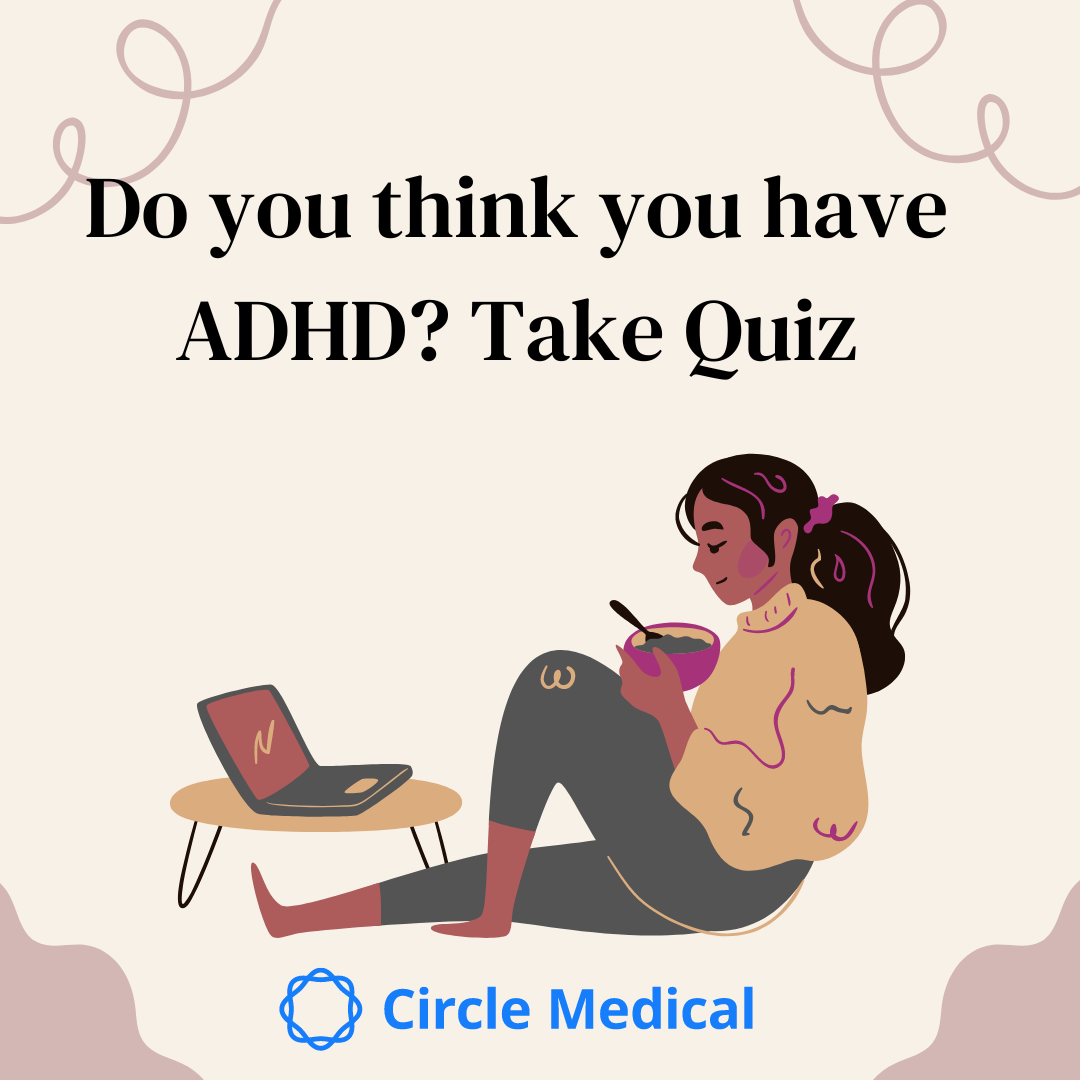
Best Online Psychiatry Services Online psychiatry, sometimes called telepsychiatry, platforms offer medication management by phone, video, or secure messaging for a variety of mental health conditions. In some cases, online psychiatry may be more affordable than seeing an in-person provider. Mental health treatment has expanded to include many online psychiatry and therapy services. With so many choices, it can feel overwhelming to find the one that is right for you.